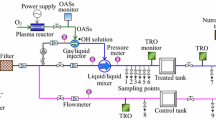Abstract
Objective
To assess whetherLegionella pneumophila serogroup 1 and serogroup 6,Escherichia coli, andStaphylococcus aureus can survive in Japan Sea Proper Water (JSPW).
Methods
The inhibitory effects of JSPW, surface seawater (SSW), phosphate buffer solution with 3.5% NaCl of pH 7.0 (3.5% NaCIPBS), and the 102- and 104-fold dilute solutions with purified water or phosphate buffer solution of pH 7.0, and purified water were investigated. Survival cells were counted immediately after the water and the bacteria were mixed, and at 1,3,5, and 7 days after incubation at 37°C. If the number of surviving cells was decreased more than 2 log units compared with the starting value, we judged the medium to have had an inhibitory effect on the growth of the bacteria.
Results
The survival cells of the bacteria in JSPW had decreased more than 2 log units compared with the starting value at 1 day after incubation. After 1 day of incubation, the cells ofLegionella pneumophila serogroup 6 andStaphylococcus aureus were found to have decreased more than 2 log units in purified water (PW) used as a control. Furthermore,Legionella pneumophila serogroup 1 in the 102-fold dilute solution of JSPW was only 1.04 log units lower than the starting value at 7 days after incubation. In the 102- and 104-fold dilute solutions of JSPW,Escherichia coli survived for 7 days after incubation. These results were almost similar to the results in SSW and 3.5% NaCIPBS.
Conclusions
The present findings demonstrate thatLegionella pneumophila serogroup 1 andEscherichia coli cannot survive in undiluted JSPW for over a day at 37°C, suggesting the inhibitory effects may be due to the sodium chloride contained in JSPW.
Similar content being viewed by others
References
Ueda M. Functions of hot springs and their application to medicine. J Jpn Pharmaceut Assoc. 2001;53:65–71. (Article in Japanese)
Sukenik S, Giryes H, Halevy S, Neumann L, Flusser D, Buskila D. Treatment of psoriatic arthritis at the Dead Sea. J Rheumatol. 1994;21:1305–1309.
Elkayam O, Ophir J, Brener S, Paran D, Wigler I, Efron D, et al. Immediate and delayed effects of treatment at the Dead Sea in patients with psoriatic arthritis. Rheumatol Int. 2000;19:77–82.
Buskila D, Abu-Shakra M, Neumann L, Odes L, Shneider E, Flusser D, et al. Balneotherapy for fibromyalgia at the Dead Sea. Rheumatol Int. 2001;20:105–108.
Neumann L, Sukenik S, Bolotin A, Abu-Shakra M, Amir M, Flusser D, et al. The effect of balneotherapy at the Dead Sea on the quality of life of patients with fibromyalgia syndrome. Clin Rheumatol. 2001;20:15–19.
Tsuchiya Y, Shimizu T, Tazawa T, Nakamura K, Yamamoto M. Effects of hot deep seawater bathing on the immune cell distribution in peripheral blood from healthy young men. Environ Health Prev Med. 2003;8:161–165.
Tsuchiya Y, Shimizu T, Tazawa T, Shibuya N, Nakamura K, Yamamoto M. Changes in plasma lactate and pyruvate concentrations after taking a bath in hot deep seawater. Tohoku J Exp Med. 2003;201:201–211.
Yu VL.Legionella pneumophila (Legionnaires’ disease). Mandell, Douglas and Bennett’s Principles and Practice of Infectious Disease, 5th ed. New York: Churchill Livingston; 2000.
Dutka BJ. Sensitivity ofLegionella pneumophila to sunlight in fresh and marine waters. Appl Environ Microbiol. 1984; 48: 970–974.
Ortiz-Roque CM, Hazen TC. Abundance and distribution of Legionellaceae in Puerto Rican waters. Appl Environ Microbiol. 1987;53:2231–2236.
Palmer CJ, Tsai YL, Paszko-Kolva C, Mayer C, Sangermano LR. Detection ofLegionella species in sewage and ocean water by polymerase chain reaction, direct fluorescent-antibody, and plate culture methods. Appl Environ Microbiol. 1993;59:3618–3624.
Dennis PJ, Taylor JA, Barrow GI. Phosphate buffered, low sodium chloride blood agar medium forLegionella pneumophila. Lancet. 1981;2:636.
Tesh MJ, Miller RD. Growth ofLegionella pneumophila in defined media: requirement for magnesium and potassium. Can J Microbiol. 1982;28:1055–1058.
Weiss E, Westfall HN. Substrate utilization byLegionella cells after cryopreservation in phosphate buffer. Appl Environ Microbiol. 1984;48:380–385.
Ogawa T, Fujimoto T. Characteristics of the Japan Sea Proper water. Ann Rep Inst Environ Geol Sci. 2002;13:69–79. (Article in Japanese)
world Health Organization. Legionnaires’ disease in Europe. Weekly epidemiological record. 2000;75:345–352.
Tominaga M, Aoki Y, Haraguchi S, Fukuoka M, Hayashi S, Tamesada M, et al. Legionnaires’ disease associated with habitual drinking of hot spring water. Intern Med. 2001; 40:1064–1067.
Grove DI, Lawson PJ, Burgess JS, Moran JL, O’Fathartaigh MS, Winslow WE. An outbreak ofLegionella longbeachae infection in an intensive care unit? J Hosp Infect. 2002;52: 250–258.
Bernander S, Jacobson K, Lundholm M. A hospital-associated outbreak of Legionnaires’ disease caused byLegionella pneumophila serogroups 4 and 10 with a common genetic fingerprinting pattern. APMIS. 2004;112:210–217.
Nakamura H, Yagyu H, Kishi K, Tsuchida F, Oh-ishi S, Yamaguchi K, et al. A large outbreak of Legionnaires’ disease due to an inadequate circulating and filtration system for bath water—Epidemiologic manifestations—. Intern Med. 2003; 42:806–811.
Heller R, Holler C, Sussmuth R, Gundermann KO. Effect of salt concentration and temperature on survival ofLegionella pneumophila. Lett Appl Microbiol. 1998;26:64–68.
Catrenich CE, Johnson W. Characterization of the selective inhibition of growth of virulentLegionella pneumophila by supplemented Mueller-Hinton medium. Infect Immun. 1989; 57:1862–1864.
Vickers RM, Yu VL, Hanna SS, Muraca P, Diven W, Carmen N, et al. Determinants ofLegionella pneumophila contamination of water distribution systems: 15-hospital prospective study. Infect Control. 1987;8:357–363.
Paszko-Kolva C, Shahamat M, Colwell RR. Long-term survival ofLegionella pneumophila serogroup 1 under low-nutrient conditions and associated morphological changes. FEMS Microbiol Lett. 1992;102:45–55.
Author information
Authors and Affiliations
Corresponding author
Rights and permissions
About this article
Cite this article
Tsuchiya, Y., Terao, M., Fujimoto, T. et al. Effects of Japan Sea Proper Water on the growth ofLegionella pneumophila, Escherichia coli, andStaphylococcus aureus . Environ Health Prev Med 10, 233–238 (2005). https://doi.org/10.1007/BF02897696
Received:
Accepted:
Issue Date:
DOI: https://doi.org/10.1007/BF02897696




